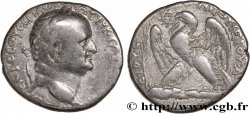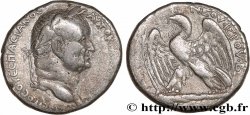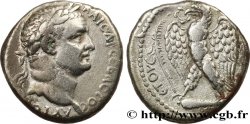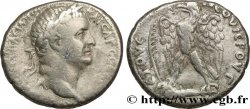v27_0722 - VESPASIANUS Aureus
MONNAIES 27 (2006)
Startpreis : 2 800.00 €
Schätzung : 4 500.00 €
Erzielter Preis : 2 800.00 €
Anzahl der Gebote : 1
Höchstgebot : 3 135.00 €
Startpreis : 2 800.00 €
Schätzung : 4 500.00 €
Erzielter Preis : 2 800.00 €
Anzahl der Gebote : 1
Höchstgebot : 3 135.00 €
Type : Aureus
Datum: 78-79
Name der Münzstätte / Stadt : Roma
Metall : Gold
Der Feingehalt beträgt : 1000 ‰
Durchmesser : 19,5 mm
Stempelstellung : 6 h.
Gewicht : 6,97 g.
Seltenheitsgrad : R2
Kommentare zum Erhaltungszustand:
Beau portrait. Trace de monture ancienne sur la tranche. Petite faiblesse de frappe au revers
N° im Nachschlagewerk :
C.- cf. 56 - RIC.132 - Liberchies- - BMC/RE.299 pl. 9/5 - BN/R.261 pl. XXXV - RCV.- - MRK. - Cal.593 - HCC.
Vorderseite
Titulatur der Vorderseite CAESAR VESPASIANVS AVG.
Beschreibung Vorderseite Tête laurée de Vespasien à gauche (O*1).
Übersetzung der Vorderseite “Cæsar Vespasianus Augustus”, (César Vespasien auguste).
Rückseite
Titulatur der Rückseite CE-RES - AVGVST.
Beschreibung Rückseite Cérès voilée et drapée debout à gauche, tenant un pavot et deux épis de la main droite et une longue torche de la main gauche.
Übersetzung der Rückseite “Ceres Augusti”, (Cérès de l’auguste).
Kommentare
H. Cohen signale un exemplaire similaire provenant de la “trouvaille du Lycée Napoléon”. Il s’agit en fait du trésor du Lycée Henri IV, découvert en 1867, contenant 774 aurei. En 1880, H. Cohen décrivait l’aureus avec une tête laurée à gauche. Dans l’inventaire original, repris par Jean Lafaurie en 1943, il s’agit bien d’une tête laurée à droite. Cet aureus n’est malheureusement pas entré au Cabinet des médailles. Rubans divergents : ruban antérieur descendant sur le cou et ruban postérieur descendant verticalement (type 2). Le bas du ruban postérieur vient toucher le S de Vespasianus. Même coin de droit que l’exemplaire du British Museum, BMC. n° 299, pl. 9/5 provenant de la collection de Blacas (1867).
H. Cohen reports a similar example from the “find of the Lycée Napoléon”. This is in fact the treasure of the Lycée Henri IV, discovered in 1867, containing 774 aurei. In 1880, H. Cohen described the aureus with a laureate head on the left. In the original inventory, taken up by Jean Lafaurie in 1943, it is indeed a laureate head on the right. This aureus unfortunately did not enter the Cabinet of Medals. Divergent ribbons: anterior ribbon descending on the neck and posterior ribbon descending vertically (type 2). The bottom of the posterior ribbon touches the S of Vespasianus. Same obverse die as the example in the British Museum, BMC. No. 299, pl. 9/5 from the Blacas collection (1867)
H. Cohen reports a similar example from the “find of the Lycée Napoléon”. This is in fact the treasure of the Lycée Henri IV, discovered in 1867, containing 774 aurei. In 1880, H. Cohen described the aureus with a laureate head on the left. In the original inventory, taken up by Jean Lafaurie in 1943, it is indeed a laureate head on the right. This aureus unfortunately did not enter the Cabinet of Medals. Divergent ribbons: anterior ribbon descending on the neck and posterior ribbon descending vertically (type 2). The bottom of the posterior ribbon touches the S of Vespasianus. Same obverse die as the example in the British Museum, BMC. No. 299, pl. 9/5 from the Blacas collection (1867)








 Berichten über einen Fehler
Berichten über einen Fehler Die Seite drucken
Die Seite drucken Teilen meiner Auswahl
Teilen meiner Auswahl Stellen Sie eine Frage
Stellen Sie eine Frage Einlieferung/Verkauf
Einlieferung/Verkauf
 Details
Details










